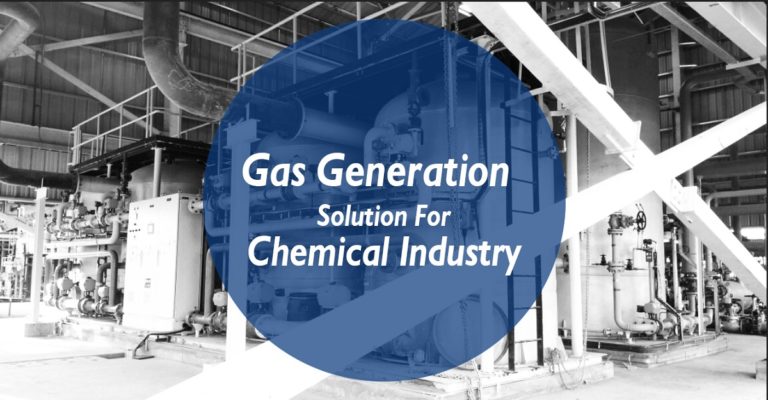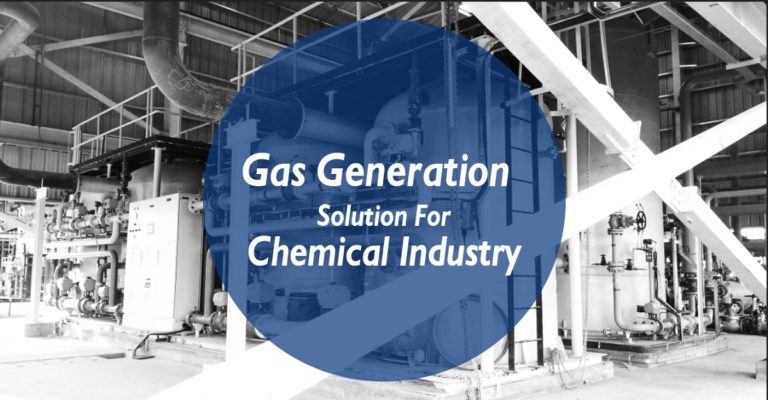All the 3 gases that are produced using world leading MVS Engineering On-Site gas generators – Nitrogen, Oxygen and Hydrogen, find use in the chemical industry. Let’s break it down.

Nitrogen
By far, Nitrogen use is most prevalent in the chemicals industry.
Customers, during various stages of handling, manufacturing, packaging of chemicals require Nitrogen for various uses.
Nitrogen is widely used as a gas that displaces oxygen and other undesirable gases. Nitrogen itself has very selective reactivity and it’s largely inert nature, allows Nitrogen to be used extensively. Nitrogen is also abundantly available – 78% nitrogen is present in atmosphere.
MVS Nitrogen generators are based on two technologies – Membrane and PSA. Where large flows and lowered purities of Nitrogen are acceptable, membrane nitrogen generators are very suitable and cost-effective. Where high purity nitrogen is required, such as to keep levels of oxygen in ppm-levels, PSA nitrogen generators are used.
In the chemicals industry, some of the major processes requiring nitrogen are – purging (before and during batch processing), blanketing (tanks and other storage volumes), packaging (to prevent reaction with oxygen and other volatile chemicals).
Oxygen
Many chemicals are processed compounds and where oxygen based compounds are produced, oxygen is necessary. MVS provides industrial grade PSA and VPSA oxygen generators, depending on the quantity of oxygen required. 95% oxygen purity (balance largely being argon and trace nitrogen) is available from PSA nitrogen plants and 93% is easily achievable by the large volume VPSA oxygen plants.
Hydrogen
Hydrogenation is a common process for preparation of many chemicals and many chemical processing companies have large requirements of Hydrogen. Hydrogen while abundantly available in nature (H2 in H2O), is not easily available in it’s molecular form. Hence, in order to get Hydrogen, it has to be “extracted” from a hydrogen rich source. Some of the most common feedstock used for Hydrogen are (1) water, (2) natural gas (methane), (3) methanol, (4) ammonia and other hydrocarbons such as naphtha, syngas from refineries etc.
Hydrogen is also widely used in the labs of chemical industries where it is used as a carrier gas or as FID in gas chromatography. For this application, very compact and small lab hydrogen generators, about the size of a typical computer CPU, are available and provide a constant, pure and reliable supply of Hydrogen.
Hydrogen is largely sourced by customers in cylinder cascades or in tube trailers. But on-site production is considered a much more safer and reliable way of producing hydrogen as it eliminates the constant need of handling cylinders or tubes.
MVS supplies various technologies for on-site hydrogen production including water electrolysis (bipolar high pressure) and water electrolysis using the latest PEM technology from Proton (NEL Hydrogen). We also supply systems using hydrocarbon reforming such as Natural Gas reformers, commonly known as Steam Methane reformer (SMR) and Methanol Crackers. Furthermore, we are one of the world’s largest manufacturer of Ammonia Crackers, which provide an excellent mix of Nitrogen (25%) and Hydrogen (75%), with low ppm levels of trace ammonia in the product gas.
—
In summary, no matter which gas is required in the chemical processing, MVS is a one stop shop for providing multiple gas generators to our customers. We have been doing this for the last 4-decades and have a reputation for providing quality, well-engineered, reliable and long lasting gas generators that withstand the test of time.
Learn more about our various products by clicking on the links below:
PSA Nitrogen
Membrane Nitrogen
Industrial Oxygen
Water Electrolysis Hydrogen
Hydrocarbon Reforming Hydrogen (Natural Gas/Methanol/Naphtha)
Ammonia Cracking Hydrogen





Your immune system is your body s way of fighting off sickness, germs, and infection where to buy cialis online Total RNA is extracted from the tumors using the RNeasy Mini Kit Qiagen, Stanford Valencia, CA according to the manufacturer s instructions